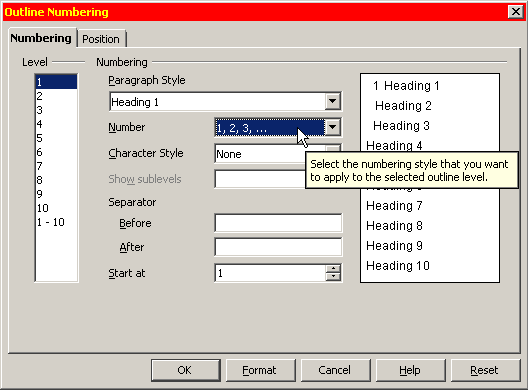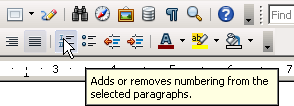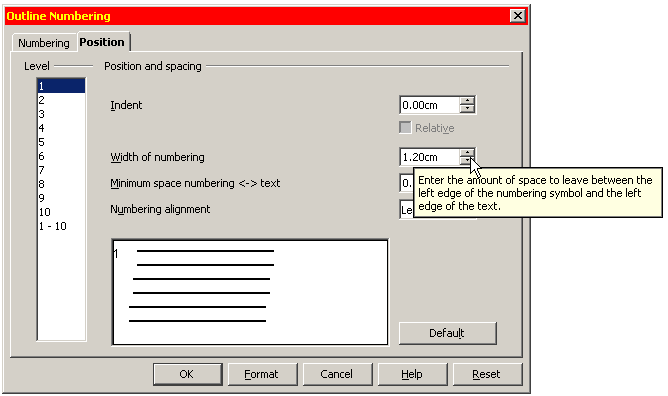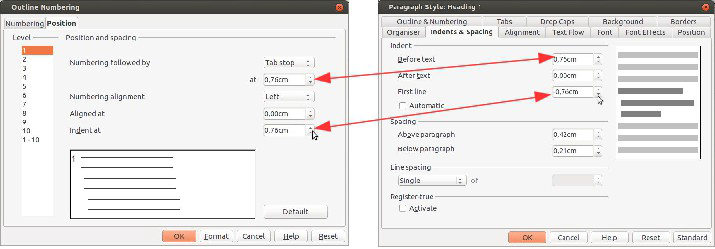Chapter Numbering
- Introduction
- Theory
- Document Structure
- Chapter Headings
- Chapter Numbering
- Table of Contents
- Outline
- Navigator
- Text Body
- Paragraph styles overview
- Reusing styles
- Default Page Formatting
- Title Page
- Papers without a Title Page
- Pages with and without numbering
- Roman Page Numbering
- Group Work
- Proofreading
- Numbered lists and bullets
- Line numbering
- Cross-references
- Footnotes
- Bibliography
- Quotes
- Tables
- Charts
- Pictures
- Snapshots
- Presentations & Graphics
- Cross tables (Statistics)
- Extra Long Web Adresses
- Fonts
- Emphasis
- Special Characters
- Non separable combinations
- Shortcut keys
- Mouse clicks
- PDFs
- Saving your files
- Several files open at once
- Search and replace
- Spell Check
- Synonyms
- Document Infos
- Labels and Form letters
- Help
- Installing Program
- Microsoft Word
- Practice I
- Practice II
Let the program do the numbering for you. That way you can add or remove chapters, change their levels or move them around with the help of the Navigator without worrying about correct numbering or having to mark text beforehand. This is especially useful for group work when it comes to combining the various chapters into one document (see sections 9 and 18.)
You switch on automatic numbering under the menu Tools › Outline Numbering (see illustration 2). You can choose between various numbering styles such as A, B, C or Roman numbers, but most likely you will stick to Arabic 1, 2, 3 style. It’s also possible to mix styles, that is, have Arabic numbers for the first two levels and a), b), c) for the third – whereby the closing bracket is simply a Separator After.
Illustration 2. Activating outline numbering
When using 1, 2, 3 style it is common to Show sublevels. This means a full lenght heading 5.2.7 instead of “7”. If you mix styles you could Show sublevels for the first two levels in Arabic style, giving you 5.2, but not for the third level, which would then appear as a simple c) instead of the full length 5.2.c). You might want to turn numbering off for particular headings, for example the introduction and the bibliography. You can do so by pressing the third button on the pop-up menu (see illustration 3). Be careful not to press the second button, because this would switch numbering off or on for all headings of that particular level!
Illustration 3. Turning off numbering for a particular chapter
Illustration 4. Activating numbering directly from the menu - good for numbered lists but not for headings
Under Position (see illustration 5) make sure Width of numbering is sufficient to contain the whole number (e.g. “5.7.2”) plus some spacing so that the heading number stands out nicely from the heading text – even if you happen to have a heading spanning several lines.
Illustration 5. Make sure "Width of numbering" is wide enough
Make sure to leave enough space for your numbering. A complete numbering such as 5.2.7 would take up around 1 cm of space. It also depends on the size font you are using. Please take a detailed look at illustration 6 for a better understanding of these settings and those for the corresponding paragraph style.
Illustration 6. You need to leave enough room for your chapter numbers. Standard for first level headings is 0,76cm. You will notice the same values alsoappear in the paragraph style Heading 1 (First line indent preceded by a minus sign though!). Make sure this correspondence between bothmenus is maintained in case you change these values. This will ensure the proper alignment of header text, each line starting neatlydirectly under the preceding lign, leaving the chapter number in its own space to the very left.




